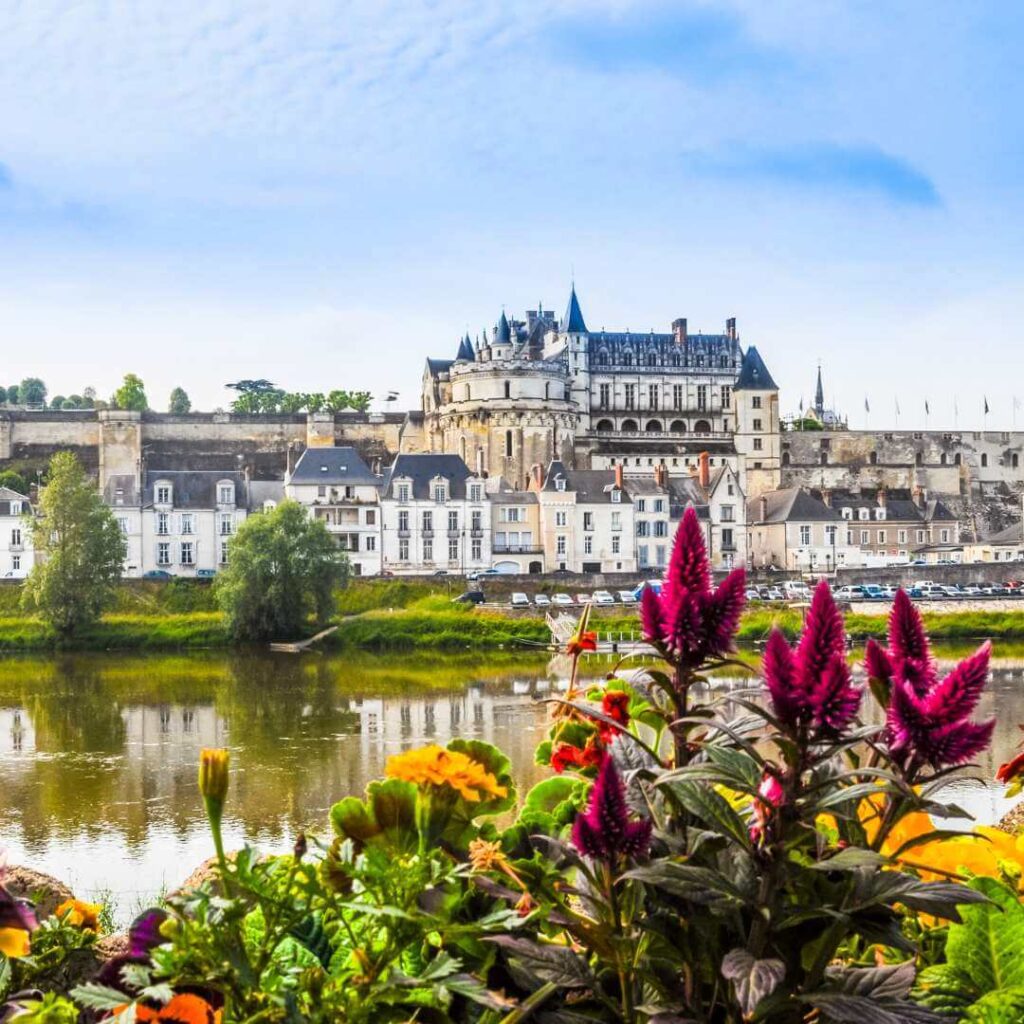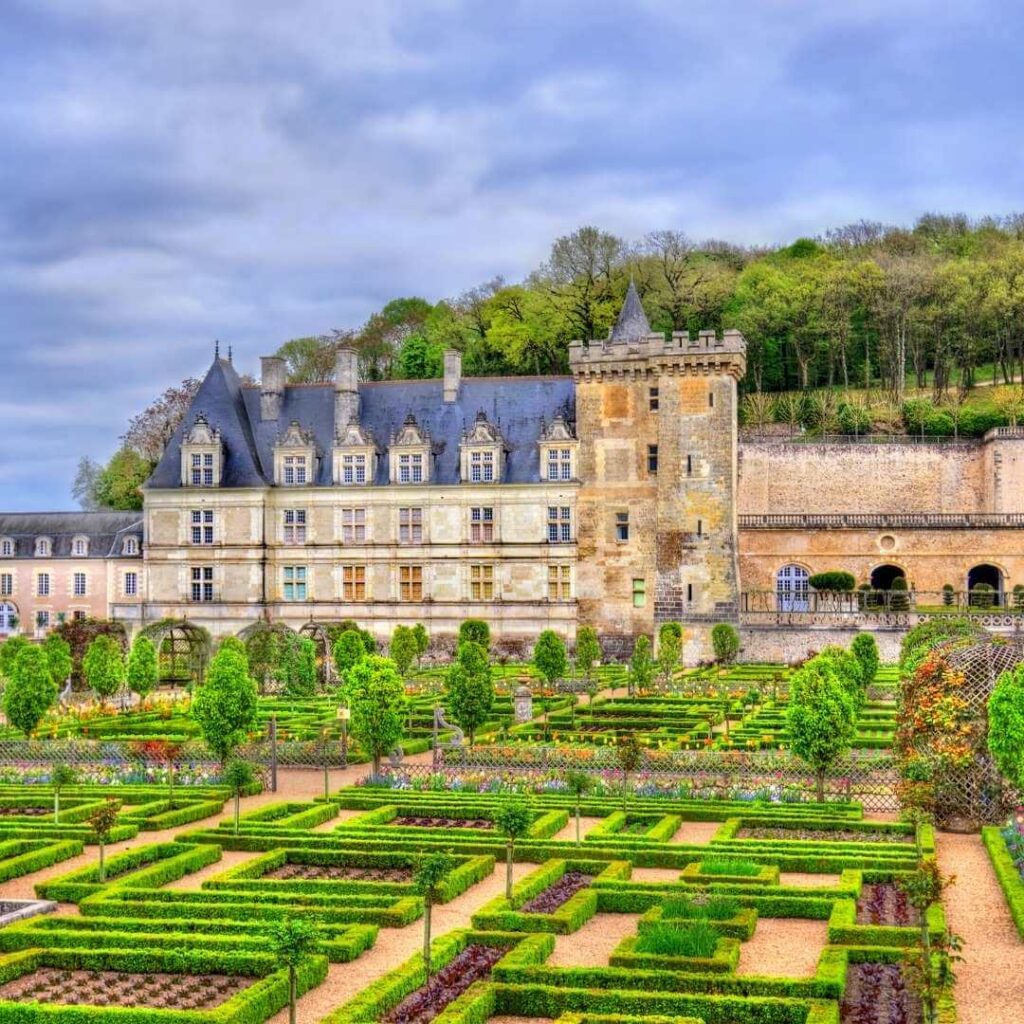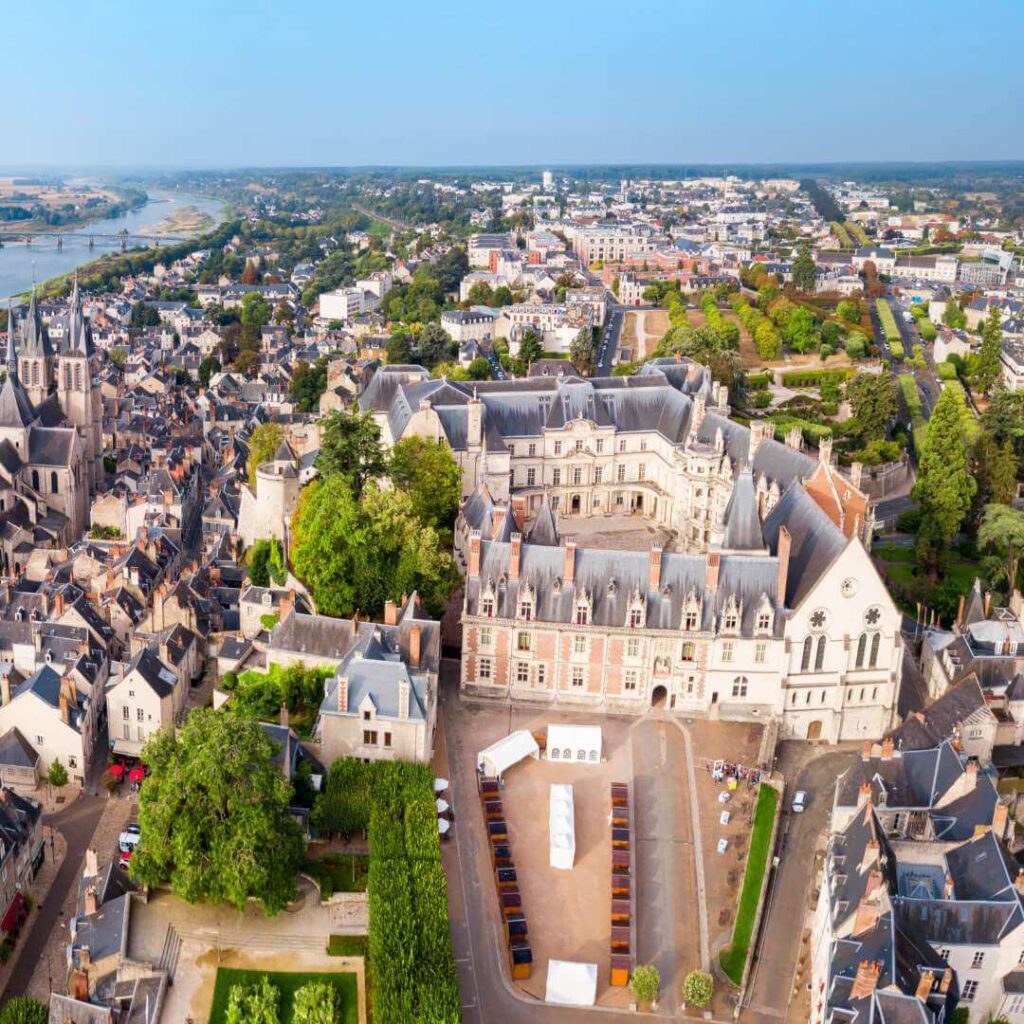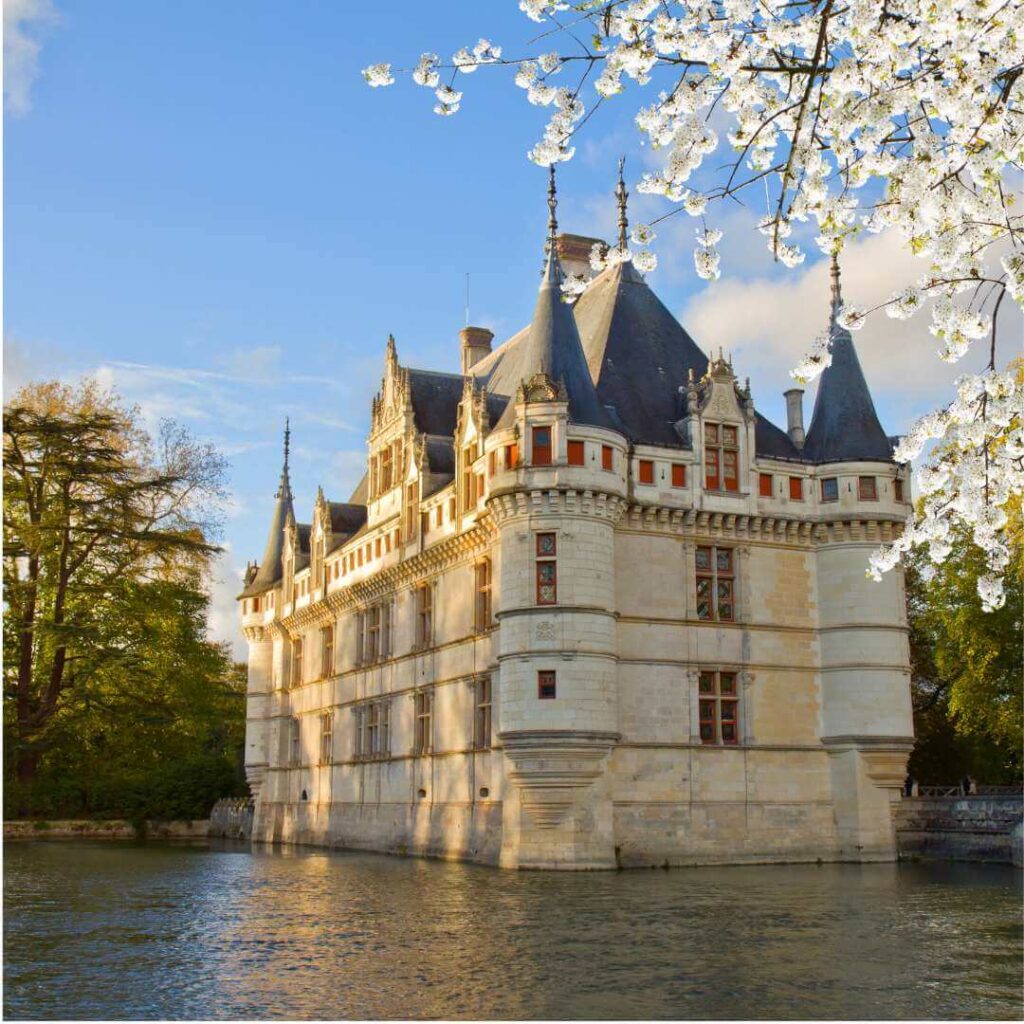The Loire Valley is a dream destination for castle lovers. This UNESCO world heritage site is home to more than 300 châteaux, each with its own fascinating history and architectural beauty. With so many options, choosing which Loire Valley castles to visit can feel overwhelming.
To help you plan, here’s a guide to seven of the most stunning and historically significant Loire Valley castles. These must-visit châteaux will transport you back in time with their grandeur, gardens, and royal stories.
Disclosure: This post may contain affiliate links, meaning I may get a small commission if you decide to make a purchase through my links, at no cost to you.
Château de Chambord

If you can only visit one Loire castle, make it Château de Chambord. This Renaissance masterpiece is the largest and most recognizable château in the Loire Valley. Built under King François I, it was designed to impress rather than serve as a royal residence.
Why Visit?
- The Iconic Double Helix Staircase – Thought to be inspired by Leonardo da Vinci, it allows people to ascend and descend without crossing paths.
- Magnificent Rooftop Views – Climb to the terraces for a stunning panorama of the estate.
- Vast Gardens & Forests – Explore miles of formal gardens, a game reserve, and scenic walking trails.
Beyond the castle, enjoy equestrian shows, boat rentals on the canal, or a bike ride through the grounds. Chambord castle is an experience, not just a visit.
If you prefer to see multiple castles in one day, leave from Tours or Amboise on a small group tour visiting Château de Chambord and Château de Chenonceau.
Château de Chenonceau

Few castles in the world match the beauty and romance of Château de Chenonceau, the elegant “Ladies Castle”.
One of the most stunning features of Chenonceau castle is where it’s constructed, spanning the Cher River. This château is famous for its arched bridge, refined interiors, and its history shaped by influential women.
Why Visit?
- Gorgeous River Setting – The château’s reflection in the water creates breathtaking views.
- Diane de Poitiers vs. Catherine de’ Medici – Learn about the two women who shaped its history and gardens.
- WWII Escape Route – The gallery spanning the river served as a secret passage for people fleeing Nazi-occupied France.
Stroll through the lavish French Renaissance gardens and enjoy the peaceful tree-lined avenues surrounding the estate.
If you prefer to visit the castle without the stress of getting there, consider a small group tour to Château de Chambord and Château de Chenonceau with lunch at the family-owned Chateau de Villesavin.
Château d’Amboise

Perched above the town of Amboise, this castle was a royal residence for French kings and an important Renaissance center. Leonardo da Vinci himself was invited here by King Francis I.
Château dAmboise also holds one of the Loire Valley’s most famous graves: Leonardo da Vinci’s final resting place.
Why Visit?
- Stunning Views – The château’s terrace offers panoramic views over the Loire River and town.
- Leonardo da Vinci’s Tomb – Visit the Saint-Hubert Chapel, where the legendary artist is buried.
- Blend of Gothic & Renaissance Architecture – See how different architectural styles merge beautifully.
While in Amboise, visit Clos Lucé, da Vinci’s former residence, just a short walk from the castle. It features models of his inventions and interactive exhibits.
Château de Villandry

Château de Villandry is famous not for its castle, but for its spectacular gardens. The château itself is elegant, but the outdoor spaces steal the show.
Every inch of these gardens is carefully designed to create geometric perfection.
Why Visit?
- The Ornamental Gardens – Immaculately shaped hedges form intricate designs symbolizing love, passion, and tragedy.
- The Kitchen Garden – A vibrant mosaic of vegetables and flowers arranged in perfect symmetry.
- The Water Garden – A serene space with reflecting pools and fountains.
Visit in spring or summer when the flowers are in full bloom. Villandry’s gardens change throughout the year, making every visit unique.
Château de Blois

Unlike other Loire Valley castles, Château de Blois is a fusion of four different architectural styles.
Home to seven kings and ten queens, this château was at the center of royal intrigue, political drama, and assassinations.
Why Visit?
- Four Architectural Styles in One Castle – Gothic, Flamboyant, Renaissance, and Classical.
- The Stunning Staircase of Francis I – A beautifully carved spiral staircase.
- Royal History & Mystery – This was the scene of the infamous assassination of the Duke of Guise in 1588.
Located in the heart of Blois, this château is perfect for a half-day visit combined with exploring the charming town.
Château de Cheverny

Cheverny offers an elegant and fully furnished glimpse into aristocratic life. Unlike many castles, Château de Cheverny remains privately owned and has been in the same family for over six centuries.
Why Visit?
- Preserved 17th-Century Interiors – Experience what a lived-in château felt like with its original furniture and lavish decor.
- Six Themed Gardens – Visit the Tulip Garden (stunning in April), the Kitchen Garden, and the bay tree maze.
- The Famous Hunting Dogs – The estate houses a pack of over 100 hunting dogs, and you may even catch a feeding demonstration.
If you’re a fan of The Adventures of Tintin, Cheverny will feel familiar. It inspired Captain Haddock’s Marlinspike Hall in the comics.
Château d’Azay-le-Rideau

Built on an island in the Indre River, Château d’Azay-le-Rideau is one of the most romantic castles in France.
Its water reflections create a picture-perfect setting that looks like something from a storybook.
Why Visit?
- Stunning Renaissance Architecture – Its symmetrical design and delicate details make it a masterpiece.
- The “Mirror Effect” – The reflection of the château in the river adds to its dreamy atmosphere.
- A Peaceful Setting – Wander through the landscaped English-style gardens for scenic views.
Azay-le-Rideau’s compact size and breathtaking location make it a favorite for photographers and travelers looking for a romantic escape.
The Bottom Line: Which Loire Valley Castles Should You Visit?
From grand royal palaces to fairytale retreats, these Loire Valley Châteaux offer something for every traveler.
- For grandeur and scale → Visit Château de Chambord
- For elegance and romance → Explore Château de Chenonceau
- For French Renaissance history → See Château d’Amboise
- For spectacular gardens → Wander Château de Villandry
- For a mix of styles and history → Visit Château de Blois
- For a lived-in feel → Experience Château de Cheverny
- For a romantic water château → Admire Château d’Azay-le-Rideau
Each château has its own charm and story, making the Loire Valley an unforgettable destination. Whether you visit for a day or spend a week exploring, these castles will transport you to France’s royal past.
If you enjoyed this post, check out our other Loire Valley blog posts or France travel blog posts.
The Loire Valley is a dream destination for castle lovers. This UNESCO world heritage site is home to more than 300 châteaux, each with its own fascinating history and architectural beauty. With so many options, choosing which Loire Valley castles to visit can feel overwhelming.
To help you plan, here’s a guide to seven of the most stunning and historically significant Loire Valley castles. These must-visit châteaux will transport you back in time with their grandeur, gardens, and royal stories.
Disclosure: This post may contain affiliate links, meaning I may get a small commission if you decide to make a purchase through my links, at no cost to you.
Château de Chambord

If you can only visit one Loire castle, make it Château de Chambord. This Renaissance masterpiece is the largest and most recognizable château in the Loire Valley. Built under King François I, it was designed to impress rather than serve as a royal residence.
Why Visit?
- The Iconic Double Helix Staircase – Thought to be inspired by Leonardo da Vinci, it allows people to ascend and descend without crossing paths.
- Magnificent Rooftop Views – Climb to the terraces for a stunning panorama of the estate.
- Vast Gardens & Forests – Explore miles of formal gardens, a game reserve, and scenic walking trails.
Beyond the castle, enjoy equestrian shows, boat rentals on the canal, or a bike ride through the grounds. Chambord castle is an experience, not just a visit.
If you prefer to see multiple castles in one day, leave from Tours or Amboise on a small group tour visiting Château de Chambord and Château de Chenonceau.
Château de Chenonceau

Few castles in the world match the beauty and romance of Château de Chenonceau, the elegant “Ladies Castle”.
One of the most stunning features of Chenonceau castle is where it’s constructed, spanning the Cher River. This château is famous for its arched bridge, refined interiors, and its history shaped by influential women.
Why Visit?
- Gorgeous River Setting – The château’s reflection in the water creates breathtaking views.
- Diane de Poitiers vs. Catherine de’ Medici – Learn about the two women who shaped its history and gardens.
- WWII Escape Route – The gallery spanning the river served as a secret passage for people fleeing Nazi-occupied France.
Stroll through the lavish French Renaissance gardens and enjoy the peaceful tree-lined avenues surrounding the estate.
If you prefer to visit the castle without the stress of getting there, consider a small group tour to Château de Chambord and Château de Chenonceau with lunch at the family-owned Chateau de Villesavin.
Château d’Amboise

Perched above the town of Amboise, this castle was a royal residence for French kings and an important Renaissance center. Leonardo da Vinci himself was invited here by King Francis I.
Château dAmboise also holds one of the Loire Valley’s most famous graves: Leonardo da Vinci’s final resting place.
Why Visit?
- Stunning Views – The château’s terrace offers panoramic views over the Loire River and town.
- Leonardo da Vinci’s Tomb – Visit the Saint-Hubert Chapel, where the legendary artist is buried.
- Blend of Gothic & Renaissance Architecture – See how different architectural styles merge beautifully.
While in Amboise, visit Clos Lucé, da Vinci’s former residence, just a short walk from the castle. It features models of his inventions and interactive exhibits.
Château de Villandry

Château de Villandry is famous not for its castle, but for its spectacular gardens. The château itself is elegant, but the outdoor spaces steal the show.
Every inch of these gardens is carefully designed to create geometric perfection.
Why Visit?
- The Ornamental Gardens – Immaculately shaped hedges form intricate designs symbolizing love, passion, and tragedy.
- The Kitchen Garden – A vibrant mosaic of vegetables and flowers arranged in perfect symmetry.
- The Water Garden – A serene space with reflecting pools and fountains.
Visit in spring or summer when the flowers are in full bloom. Villandry’s gardens change throughout the year, making every visit unique.
Château de Blois

Unlike other Loire Valley castles, Château de Blois is a fusion of four different architectural styles.
Home to seven kings and ten queens, this château was at the center of royal intrigue, political drama, and assassinations.
Why Visit?
- Four Architectural Styles in One Castle – Gothic, Flamboyant, Renaissance, and Classical.
- The Stunning Staircase of Francis I – A beautifully carved spiral staircase.
- Royal History & Mystery – This was the scene of the infamous assassination of the Duke of Guise in 1588.
Located in the heart of Blois, this château is perfect for a half-day visit combined with exploring the charming town.
Château de Cheverny

Cheverny offers an elegant and fully furnished glimpse into aristocratic life. Unlike many castles, Château de Cheverny remains privately owned and has been in the same family for over six centuries.
Why Visit?
- Preserved 17th-Century Interiors – Experience what a lived-in château felt like with its original furniture and lavish decor.
- Six Themed Gardens – Visit the Tulip Garden (stunning in April), the Kitchen Garden, and the bay tree maze.
- The Famous Hunting Dogs – The estate houses a pack of over 100 hunting dogs, and you may even catch a feeding demonstration.
If you’re a fan of The Adventures of Tintin, Cheverny will feel familiar. It inspired Captain Haddock’s Marlinspike Hall in the comics.
Château d’Azay-le-Rideau

Built on an island in the Indre River, Château d’Azay-le-Rideau is one of the most romantic castles in France.
Its water reflections create a picture-perfect setting that looks like something from a storybook.
Why Visit?
- Stunning Renaissance Architecture – Its symmetrical design and delicate details make it a masterpiece.
- The “Mirror Effect” – The reflection of the château in the river adds to its dreamy atmosphere.
- A Peaceful Setting – Wander through the landscaped English-style gardens for scenic views.
Azay-le-Rideau’s compact size and breathtaking location make it a favorite for photographers and travelers looking for a romantic escape.
The Bottom Line: Which Loire Valley Castles Should You Visit?
From grand royal palaces to fairytale retreats, these Loire Valley Châteaux offer something for every traveler.
- For grandeur and scale → Visit Château de Chambord
- For elegance and romance → Explore Château de Chenonceau
- For French Renaissance history → See Château d’Amboise
- For spectacular gardens → Wander Château de Villandry
- For a mix of styles and history → Visit Château de Blois
- For a lived-in feel → Experience Château de Cheverny
- For a romantic water château → Admire Château d’Azay-le-Rideau
Each château has its own charm and story, making the Loire Valley an unforgettable destination. Whether you visit for a day or spend a week exploring, these castles will transport you to France’s royal past.
If you enjoyed this post, check out our other Loire Valley blog posts or France travel blog posts.